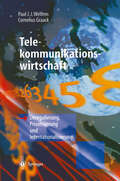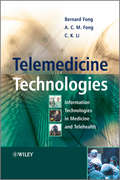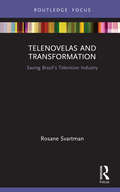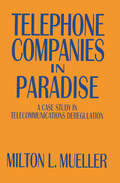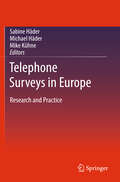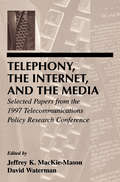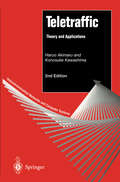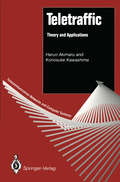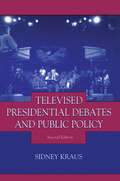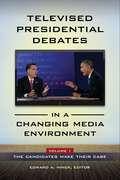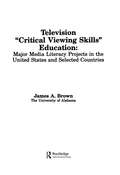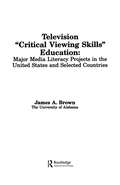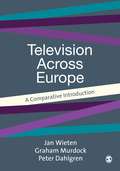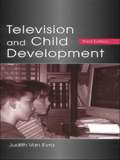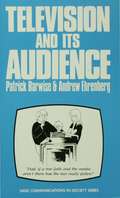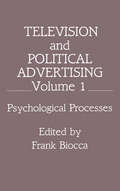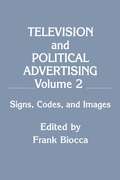- Table View
- List View
Telekommunikationswirtschaft: Deregulierung, Privatisierung und Internationalisierung
by Paul J.J. Welfens Cornelius GraackTelemedicine Technologies: Information Technologies in Medicine and Telehealth
by Bernard Fong A. C. Fong C. K. LiThis book brings together a broad range of topics demonstrating how information and wireless technologies can be used in healthcare In this book, the authors focus on how medical information can be reliably transmitted through wireless communication networks. It explains how they can be optimized to carry medical information in various situations by utilizing readily available traditional wireless local area network (WLAN) and broadband wireless access (BWA) systems. In addition, the authors discuss consumer healthcare technology, which is becoming more popular as reduction in manufacturing cost of electronics products makes healthcare products more affordable to the general public. Finally, the book explores topics such as communication networks and services, patient monitoring, information processing, system deployment, data security and privacy, information technology in alternative medicine, multimedia and health informatics, and caring for the community. Key Features: Focuses on the transmission of medical information over wireless communication networks, and addresses topics such as communication networks and services, patient monitoring, information processing, system deployment, data security and privacy, and many others Provides an in-depth introduction to the various factors that need to be considered for supporting healthcare services with information technology Covers advancements in topics such as RFID in healthcare Discusses medical signal processing as well as ECG and signal processing techniques This book will be of interest to advanced students and professors in biomedical engineering, bioinformatics, and information engineering. Medical and IT professionals involved in specifying new facilities, healthcare practitioners in telemedicine, researchers in wireless communications and information technology, and network administrators will also find this book insightful.
Telemedicine Technologies: Information Technologies in Medicine and Telehealth
by Bernard Fong A. C. Fong C. K. LiThis book brings together a broad range of topics demonstrating how information and wireless technologies can be used in healthcare In this book, the authors focus on how medical information can be reliably transmitted through wireless communication networks. It explains how they can be optimized to carry medical information in various situations by utilizing readily available traditional wireless local area network (WLAN) and broadband wireless access (BWA) systems. In addition, the authors discuss consumer healthcare technology, which is becoming more popular as reduction in manufacturing cost of electronics products makes healthcare products more affordable to the general public. Finally, the book explores topics such as communication networks and services, patient monitoring, information processing, system deployment, data security and privacy, information technology in alternative medicine, multimedia and health informatics, and caring for the community. Key Features: Focuses on the transmission of medical information over wireless communication networks, and addresses topics such as communication networks and services, patient monitoring, information processing, system deployment, data security and privacy, and many others Provides an in-depth introduction to the various factors that need to be considered for supporting healthcare services with information technology Covers advancements in topics such as RFID in healthcare Discusses medical signal processing as well as ECG and signal processing techniques This book will be of interest to advanced students and professors in biomedical engineering, bioinformatics, and information engineering. Medical and IT professionals involved in specifying new facilities, healthcare practitioners in telemedicine, researchers in wireless communications and information technology, and network administrators will also find this book insightful.
Telenovelas and Transformation: Saving Brazil’s Television Industry (Routledge Advances in Transmedia Studies)
by Rosane SvartmanThis book investigates how telenovelas may be the key to the future of Brazilian television and how this content can survive in an interconnected media landscape. Recognised telenovela writer and scholar Rosane Svartman considers the particular characteristics of the telenovela format – number of episodes, melodrama influence, and influence of the audience on future writing – to explore how these can be preserved on multimedia platforms, and the challenges this change may present. Svartman further charts the transformations of the telenovela throughout its history and its major influences and unveils the main storytelling elements and writing processes. Chapters examine the business model of Brazilian corporate television within the current context of hypermedia and analyse how this relationship evolves as it is influenced by the new interactive tools and technologies that amplify the audience’s power. Merging empirical practices and theory, this book will be of great interest to scholars and students of transmedia storytelling, television studies, and Latin American media, as well as professionals working in these areas.
Telenovelas and Transformation: Saving Brazil’s Television Industry (Routledge Advances in Transmedia Studies)
by Rosane SvartmanThis book investigates how telenovelas may be the key to the future of Brazilian television and how this content can survive in an interconnected media landscape. Recognised telenovela writer and scholar Rosane Svartman considers the particular characteristics of the telenovela format – number of episodes, melodrama influence, and influence of the audience on future writing – to explore how these can be preserved on multimedia platforms, and the challenges this change may present. Svartman further charts the transformations of the telenovela throughout its history and its major influences and unveils the main storytelling elements and writing processes. Chapters examine the business model of Brazilian corporate television within the current context of hypermedia and analyse how this relationship evolves as it is influenced by the new interactive tools and technologies that amplify the audience’s power. Merging empirical practices and theory, this book will be of great interest to scholars and students of transmedia storytelling, television studies, and Latin American media, as well as professionals working in these areas.
Telephone Companies in Paradise: A Case Study in Telecommunications Deregulation
by Milton L. MuellerComputerization has generated dramatic advances In telecommunications, such as mobile telephones and video conferencing. Coupled with this are major changes in regulation, as telephone companies face new competitors. States are experimenting with new forms of utility regulation and deregulation in order to cope with the demands of rising competition. Here Mueller examines in detail the results of a radical telephone regulation law.In 1986, the state of Nebraska completely discarded traditional utility regulation, deregulating rates and profits of its local telephone companies. The Nebraska experiment has become a benchmark for reassessing the role of state regulation In the future of telecommunications. Using comparative data from five midwestern states, Mueller shows how deregulation affected rates, investment, infrastructure modernization, and profits. He uncovers both positive and negative results. Mueller found established telephone companies to be basically conservative, not aggressive and expansionist, and concludes that new competition, not regulation or deregulation, is transforming the telecommunications industry.This book is the first systematic empirical study of the controversial Nebraska law and its broader effects. It will be a significant addition to the much debated issue of telecommunications deregulation. Economists, policymakers, and telecommunications managers will find in this volume a substantial resource. According to Robert Atkinson, senior vice president of Teleport Communications Group: "Nebraska's experiences with telecommunications deregulation - the good, the bad and the ugly - need to be understood by all telecommunications policymakers across the country so that they can emulate Nebraska's successes and avoid its mistakes. Mueller provides the roadmap."
Telephone Companies in Paradise: A Case Study in Telecommunications Deregulation
by Milton L. MuellerComputerization has generated dramatic advances In telecommunications, such as mobile telephones and video conferencing. Coupled with this are major changes in regulation, as telephone companies face new competitors. States are experimenting with new forms of utility regulation and deregulation in order to cope with the demands of rising competition. Here Mueller examines in detail the results of a radical telephone regulation law.In 1986, the state of Nebraska completely discarded traditional utility regulation, deregulating rates and profits of its local telephone companies. The Nebraska experiment has become a benchmark for reassessing the role of state regulation In the future of telecommunications. Using comparative data from five midwestern states, Mueller shows how deregulation affected rates, investment, infrastructure modernization, and profits. He uncovers both positive and negative results. Mueller found established telephone companies to be basically conservative, not aggressive and expansionist, and concludes that new competition, not regulation or deregulation, is transforming the telecommunications industry.This book is the first systematic empirical study of the controversial Nebraska law and its broader effects. It will be a significant addition to the much debated issue of telecommunications deregulation. Economists, policymakers, and telecommunications managers will find in this volume a substantial resource. According to Robert Atkinson, senior vice president of Teleport Communications Group: "Nebraska's experiences with telecommunications deregulation - the good, the bad and the ugly - need to be understood by all telecommunications policymakers across the country so that they can emulate Nebraska's successes and avoid its mistakes. Mueller provides the roadmap."
Telephone Surveys in Europe: Research and Practice
by Sabine Häder Michael Häder Mike KühneThe first part of this book deals with the coverage of landline and mobile phones in Europe. It presents an overview of the coverage and the use of phones as well as the resulting strategies for telephone surveys. The second part addresses the challenge of so-called “mobile‐only” households for survey research. Numerous statisticians present new sampling strategies like dual frame designs and findings of current projects. In dual frame designs, respondents are contacted both via mobile phone and landline. The third part focuses on the usage of mobile phones in the general population, while the fourth part of examines if different modes of data collection (mobile vs. landline) have an impact on the response quality. The last part analyses the first chapter and offers suggestions and advice on how to conduct surveys and polls, in both academic and market research.
Telephony, the Internet, and the Media: Selected Papers From the 1997 Telecommunications Policy Research Conference (LEA Telecommunications Series)
by Jeffrey K. MacKie-Mason David WatermanCommemorating the 25th anniversary of the Telecommunications Policy Research Conference (TPRC), this volume begins with a historical survey of a quarter-century of TPRC meetings as one measure of change in and research about the telecommunications industry. Additional papers reflecting the ongoing pace of change in technological, economic, and policy issues are organized around four topics: * economic analysis of local and international telephone policy; * media industry studies including video competition, guidelines for children's educational television, and the setting of AM stereo standards; * applications and policy regarding the Internet; and * comparative studies in telephone and satellite policy. Collectively, the contents of this volume assess key issues for scholars, policymakers, and practitioners. Research reported in this volume illustrates the continually expanding scope of scholarly concerns about the telecommunications and information industry and contributes to further policy research and analysis.
Telephony, the Internet, and the Media: Selected Papers From the 1997 Telecommunications Policy Research Conference (LEA Telecommunications Series)
by David Waterman Jeffrey K. MacKie-MasonCommemorating the 25th anniversary of the Telecommunications Policy Research Conference (TPRC), this volume begins with a historical survey of a quarter-century of TPRC meetings as one measure of change in and research about the telecommunications industry. Additional papers reflecting the ongoing pace of change in technological, economic, and policy issues are organized around four topics: * economic analysis of local and international telephone policy; * media industry studies including video competition, guidelines for children's educational television, and the setting of AM stereo standards; * applications and policy regarding the Internet; and * comparative studies in telephone and satellite policy. Collectively, the contents of this volume assess key issues for scholars, policymakers, and practitioners. Research reported in this volume illustrates the continually expanding scope of scholarly concerns about the telecommunications and information industry and contributes to further policy research and analysis.
Teletraffic: Theory and Applications (Telecommunication Networks and Computer Systems)
by Haruo Akimaru Konosuke KawashimaContemporary information networks are developing to meet social demands, and as a result new technologies and systems are being introduced. The fundamental problem in this process is the optimization of system dimensions and configuration for a particular level of performance. In the second edition of this innovative text, basic teletraffic theories and their applications are described in detail and practical formulae for advanced models, with references for further reading, are provided. Examples and exercises illustrate the theories' application to real systems. The revised and expanded text includes sections on ATM (asynchronous transfer mode) with the latest performance evaluations for mixed bursty traffic and bursty traffic with finite buffers, and LANs (local area networks) with an improved performance evaluation method for CSMD/CD (Ethernet). Explanations throughout the book have also been refined. The second edition of Teletraffic is a translation and expansion of the original Japanese text by two leading authors. It enables researchers, engineers and telecommunication and computer network managers, even those not experts in teletraffic, to put the latest theories and engineering into practice.
Teletraffic: Theory and Applications (Telecommunication Networks and Computer Systems)
by Haruo Akimaru Konosuke KawashimaTelecommunications systems have been evolving from the conventional telephone network that mainly deals with voice, to the ISDN (integrated services digital net work) integrating voice, data and image. Moreover, the ATM (asynchronous trans fer mode) and optical switching technologies are being developed for the broadband ISDN which can handle the high speed video communications as well. Computer networks are also progressing from centralized TSS (time-sharing system) to dis tributed LAN (local area network) and VAN (value added network). In the research, development, design and operation of such telecommunications and computer networks, the important problems are determining the optimum con figuration and dimensions of the systems for providing a given performance or GOS (grade of service). The teletraflic theory, the basis for the performance evaluation and the dimensioning, has been studied along with the switching technology, and has developed rapidly by incorporating the recent advances in OR (operations research) and queueing theory. However, it is sometimes difficult for non-experts of teletraffic to understand and apply these theories, because they require a deep mathematical background.
Televised Presidential Debates and Public Policy (Communication and Society)
by Sidney KrausWith this second edition, Kraus continues his examination of formal presidential debates, considering the experience of television in presidential elections, reviewing what has been learned about televised debates, and evaluating that knowledge in the context of the election process, specifically, and the political process, generally. He also examines the media and the role they occupy in presidential elections. Because critics often refer to the Lincoln-Douglas debates when reproaching presidential debates, comparisons of the two are discussed throughout the book. Much of the data and information for this accounting of televised presidential debates comes from the author's first-hand experience as one who was involved with these debates as a participant observer, on site at nearly all of the debates discussed. Throughout these discussions, emphasis is placed on the implications for public policy. To suggest policy that will be accepted and adopted by politicians and the public is, at best, difficult. Proposals for changes in public policy based on experience -- even when scientific data support those changes -- must be subjected to an assessment of the values and predispositions of the proponent. These values and predispositions, however, may not necessarily inhibit the proponent's objectivity. As such, this review of television use in the presidential election process provides the context for examining televised debates.
Televised Presidential Debates and Public Policy: Televised Presidential Debates And Public Policy (Communication and Society)
by Sidney KrausWith this second edition, Kraus continues his examination of formal presidential debates, considering the experience of television in presidential elections, reviewing what has been learned about televised debates, and evaluating that knowledge in the context of the election process, specifically, and the political process, generally. He also examines the media and the role they occupy in presidential elections. Because critics often refer to the Lincoln-Douglas debates when reproaching presidential debates, comparisons of the two are discussed throughout the book. Much of the data and information for this accounting of televised presidential debates comes from the author's first-hand experience as one who was involved with these debates as a participant observer, on site at nearly all of the debates discussed. Throughout these discussions, emphasis is placed on the implications for public policy. To suggest policy that will be accepted and adopted by politicians and the public is, at best, difficult. Proposals for changes in public policy based on experience -- even when scientific data support those changes -- must be subjected to an assessment of the values and predispositions of the proponent. These values and predispositions, however, may not necessarily inhibit the proponent's objectivity. As such, this review of television use in the presidential election process provides the context for examining televised debates.
Televised Presidential Debates in a Changing Media Environment [2 volumes]: [2 volumes]
by Edward A. HinckThis two-volume set examines recent presidential and vice presidential debates, addresses how citizens make sense of these events in new media, and considers whether the evolution of these forms of consumption is healthy for future presidential campaigns—and for democracy.The presidential debates of 2016 underscored how television highlights candidates' and campaigns' messages, which provide fodder for citizens' widespread use of new media to "talk back" to campaigns and other citizens. Social media will continue to affect the way that campaign events like presidential debates are consumed by audiences and how they shape campaign outcomes. This two-volume study is one of the first to examine the relationship between debates as televised events and events consumed by citizens through social media. It also assesses the town hall debate format from 1992 to 2016, uses the lens of civil dialogue to consider how citizens watch the debates, and considers the growing impact of new media commentary on candidate images that emerge in presidential and vice presidential debates.Televised Presidential Debates in a Changing Media Environment features contributions from leading political communication scholars that illuminate how presidential debates are transforming from events that are privately contemplated by citizens, to events that are increasingly viewed and discussed by citizens through social media. The first volume focuses on traditional studies of debates as televised campaign events, and the second volume examines the changing audiences for debates as they become consumed and discussed by viewers outside the traditional channels of newspapers, cable news channels, and campaign messaging. Readers will contemplate questions of new forms, problems, and possibilities of political engagement that are resulting from citizens producing and consuming political messages in new media.
Televised Presidential Debates in a Changing Media Environment [2 volumes]: [2 volumes]
This two-volume set examines recent presidential and vice presidential debates, addresses how citizens make sense of these events in new media, and considers whether the evolution of these forms of consumption is healthy for future presidential campaigns—and for democracy.The presidential debates of 2016 underscored how television highlights candidates' and campaigns' messages, which provide fodder for citizens' widespread use of new media to "talk back" to campaigns and other citizens. Social media will continue to affect the way that campaign events like presidential debates are consumed by audiences and how they shape campaign outcomes. This two-volume study is one of the first to examine the relationship between debates as televised events and events consumed by citizens through social media. It also assesses the town hall debate format from 1992 to 2016, uses the lens of civil dialogue to consider how citizens watch the debates, and considers the growing impact of new media commentary on candidate images that emerge in presidential and vice presidential debates.Televised Presidential Debates in a Changing Media Environment features contributions from leading political communication scholars that illuminate how presidential debates are transforming from events that are privately contemplated by citizens, to events that are increasingly viewed and discussed by citizens through social media. The first volume focuses on traditional studies of debates as televised campaign events, and the second volume examines the changing audiences for debates as they become consumed and discussed by viewers outside the traditional channels of newspapers, cable news channels, and campaign messaging. Readers will contemplate questions of new forms, problems, and possibilities of political engagement that are resulting from citizens producing and consuming political messages in new media.
Television ',Critical Viewing Skills', Education: Major Media Literacy Projects in the United States and Selected Countries (Routledge Communication Series)
by James A. BrownRepresenting a significant survey and evaluation of major media literacy projects in the U.S. and selected countries throughout the world, this book covers all aspects of critical viewing skills. It provides comprehensive, theoretical and historical background about the field, the criteria for its evaluation, and various structured programs including the CVS projects and programs sponsored by school districts, individuals, non-governmental national organizations, and private companies. The book can serve as a guide for curriculum planners as well as teachers in the classroom and adult workshops -- and also parents and individual adult viewers -- in applying the best match of theories, practices, readings, and specific exercises to monitor and enhance television's role.
Television ',Critical Viewing Skills', Education: Major Media Literacy Projects in the United States and Selected Countries (Routledge Communication Series)
by James A. BrownRepresenting a significant survey and evaluation of major media literacy projects in the U.S. and selected countries throughout the world, this book covers all aspects of critical viewing skills. It provides comprehensive, theoretical and historical background about the field, the criteria for its evaluation, and various structured programs including the CVS projects and programs sponsored by school districts, individuals, non-governmental national organizations, and private companies. The book can serve as a guide for curriculum planners as well as teachers in the classroom and adult workshops -- and also parents and individual adult viewers -- in applying the best match of theories, practices, readings, and specific exercises to monitor and enhance television's role.
Television Across Europe: A Comparative Introduction (PDF)
by Dr Jan Wieten Peter Dahlgren Professor Graham MurdockCombining institutional textual and audience analysis, this book introduces students to the factors which have shaped television's development in contemporary Europe, and invites them to assess the issues that are at stake in its future. Divided into three parts, the book moves from the European broadcasting environment, through current patterns and trends in programming and programme making, to TV genres and issue-specific broadcasting. Incorporating a range of pedagogical devices: boxes of key facts, activities and notes for further reading, Television across Europe offers an essential introductory guide to television in Western Europe.
Television and Child Development
by Judith Van EvraTelevision continues to play a major role in the lives of most children and adolescents, but current research also reflects the explosive growth in new technologies and their widespread use by young people. Integrating information from communication literature as well as from child development and other psychological domains, author Judith Van Evra presents a summary and synthesis of what is currently known about the media's impact on children's physical, cognitive, social, and emotional development, to help discern the complex and significant interplay between other forces in a child's life and the use of various media. This third edition contains updated and expanded coverage of research findings and a review of changing trends in media use including computers, the Internet, books and magazines, music videos, and video games as well as television. New chapters focus on basic research designs and methodologies; cultural diversity; health-related matters and lifestyle choices; media's impact on various social-emotional aspects of a child's development; the use of technology for information and for entertainment; and intervention possibilities, parent strategies, and education. An overall conclusions section at the end of the book provides a cogent summary of findings to date and stimulates discussion of questions and ideas for future research. Television and Child Development explores how, and to what extent, television and other media actually affect children, and what role other variables may play in mediating their impact, so that we can maximize technology's potential for enriching children's cognitive, social, and emotional development, while at the same time minimizing any negative influence. This text is appropriate for researchers, teachers, and students in communications, developmental and social psychology, and education, as well as in areas of advertising, leisure studies, family studies, and health promotion.
Television and Child Development
by Judith Van EvraTelevision continues to play a major role in the lives of most children and adolescents, but current research also reflects the explosive growth in new technologies and their widespread use by young people. Integrating information from communication literature as well as from child development and other psychological domains, author Judith Van Evra presents a summary and synthesis of what is currently known about the media's impact on children's physical, cognitive, social, and emotional development, to help discern the complex and significant interplay between other forces in a child's life and the use of various media. This third edition contains updated and expanded coverage of research findings and a review of changing trends in media use including computers, the Internet, books and magazines, music videos, and video games as well as television. New chapters focus on basic research designs and methodologies; cultural diversity; health-related matters and lifestyle choices; media's impact on various social-emotional aspects of a child's development; the use of technology for information and for entertainment; and intervention possibilities, parent strategies, and education. An overall conclusions section at the end of the book provides a cogent summary of findings to date and stimulates discussion of questions and ideas for future research. Television and Child Development explores how, and to what extent, television and other media actually affect children, and what role other variables may play in mediating their impact, so that we can maximize technology's potential for enriching children's cognitive, social, and emotional development, while at the same time minimizing any negative influence. This text is appropriate for researchers, teachers, and students in communications, developmental and social psychology, and education, as well as in areas of advertising, leisure studies, family studies, and health promotion.
Television and Its Audience
by Professor Andrew Ehrenberg Professor Patrick BarwiseThis book by two leading experts takes a fresh look at the nature of television, starting from an audience perspective. It draws on over twenty years of research about the audience in the United States and Britain and about the many ways in which television is funded and organized around the world. The overall picture which emerges is of: a medium which is watched for several hours a day but usually at only a low level of involvement; an audience which views mainly for relaxation but which actively chooses favourite programmes; a flowering of new channels but with no fundamental change in what or how people watch; programmes costing millions to produce but only a few pennies to view; a wide range of programme types apparently similar to the range of print media but with nothing like the same degree of audience 'segmentation'; a global communication medium of dazzling scale, speed, and impact but which is slow at conveying complex information and perhaps less powerful than generally assumed. The book is packed with information and insights yet is highly readable. It is unique in relating so many of the issues raised by television to how we watch it. There is also a highly regarded appendix on advertising, as well as technical notes, a glossary, and references for further reading.
Television and Political Advertising: Volume I: Psychological Processes (Routledge Communication Series)
by Frank BioccaThis volume represents one of the first major scholarly effort to unravel the psychological and symbolic processing of political advertising. Utilizing survey, experimental, qualitative, and semiotic methodologies to study this phenomenon, the contributors to Television and Political Advertising trace how political ads help to interpret the psychological reality of the presidential campaign in the minds of millions of voters. A product of the National Political Advertising Research Project, this interdisciplinary effort is valuable to researchers in advertising, communication, and consumer psychology since it helps define future work on the relationship between television, politics, and the mind of the voter. This volume, Television and Political Advertising: Psychological Processes, is the first of two, and covers such topics as Models and Theories for Viewing Political Television; Psychological Processing of Issues, Images, and Form; Differential Processing of Positive and Negative Advertising; and The Psychological Contexts of Processing.
Television and Political Advertising: Volume I: Psychological Processes (Routledge Communication Series)
by Frank BioccaThis volume represents one of the first major scholarly effort to unravel the psychological and symbolic processing of political advertising. Utilizing survey, experimental, qualitative, and semiotic methodologies to study this phenomenon, the contributors to Television and Political Advertising trace how political ads help to interpret the psychological reality of the presidential campaign in the minds of millions of voters. A product of the National Political Advertising Research Project, this interdisciplinary effort is valuable to researchers in advertising, communication, and consumer psychology since it helps define future work on the relationship between television, politics, and the mind of the voter. This volume, Television and Political Advertising: Psychological Processes, is the first of two, and covers such topics as Models and Theories for Viewing Political Television; Psychological Processing of Issues, Images, and Form; Differential Processing of Positive and Negative Advertising; and The Psychological Contexts of Processing.
Television and Political Advertising: Volume Ii: Signs, Codes, and Images (Routledge Communication Series)
by Frank BioccaThis volume represents one of the first major scholarly efforts to unravel the psychological and symbolic processing of political advertising. Utilizing survey, experimental, qualitative, and semiotic methodologies to study this phenomenon, the contributors to Television and Political Advertising trace how political ads help to interpret the psychological reality of the presidential campaign in the minds of millions of voters. A product of the National Political Advertising Research Project, this interdisciplinary effort is valuable to researchers in advertising, communication, and consumer psychology since it helps define future work on the relationship between television, politics, and the mind of the voter. This volume, Television and Political Advertising: Signs, Codes and Images, is the second of two, and covers such areas as Generating Meaning in the Pursuit of Power, Analyses of the Meaning of Political Ads, The Campaign Documentary as an Ad, and Regulating Signs and Images.
